Before the ink even dried on the layoff announcements, tech and social media companies are already hiring again?
By Wolf Richter for WOLF STREET.
Companies started to rebalance their workforce, after the chaos and excesses of the pandemic. The information sector, where the layoff announcements are concentrated, worked off the entire pandemic pile of excesses, and companies started to hire again. Other sectors are still short on staff, such as teaching, or in the leisure and hospitality industry, where low wages, odd hours, and split shifts have induced workers to look for the greener grass elsewhere. In manufacturing, demand for workers is still historically high, but has come down from the astronomical zone. Retail normalized last year.
So overall, job openings fell again in March, but were still 31% higher than in March 2019, the last “normal” March, based on data from the Job Openings and Labor Turnover Survey (JOLTS), released by the Bureau of Labor Statistics today. This is not based on job postings, but on surveys sent to 21,000 businesses, asking them about their actual workforce details.
Companies rebalance job openings, after the excesses of the past two years. Job openings in March at 9.59 seasonally adjusted – and at 9.36 million not seasonally adjusted – were still above the Good Times trend before the pandemic (green line). But you can see the craziness that ensued in 2021, and how companies are now systematically working off the excesses. The chart shows the three-month moving average not seasonally adjusted:
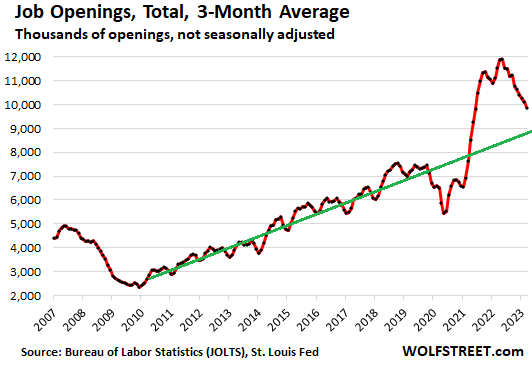
Hiring has been in the same range since October. The three-month moving average in March dipped to 6.21 million newly hired workers, roughly where it had been in October 2022:
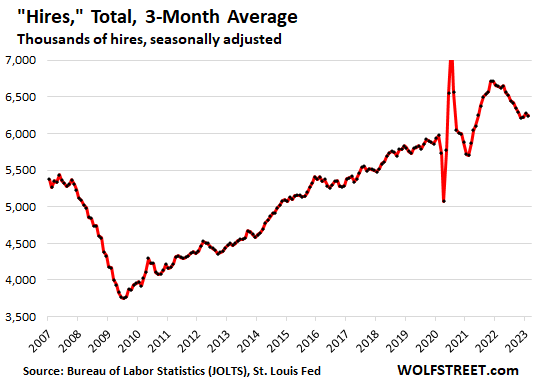
Rebalancing is taking place via layoffs and discharges, but they still remain very low. The three-month moving average of layoffs and discharges rose to 1.69 million in March, now reaching the low end of the range during the Good Times.
Companies always discharge people for a variety of reasons; when these discharges are deemed to be for economic reasons, they’re considered layoffs. During the Good Times before the pandemic, actual layoffs and discharges averaged around 1.8 million per month.
These are actual layoffs and discharges by employers in the US, not announcements of global layoffs that may not even take place in the US.
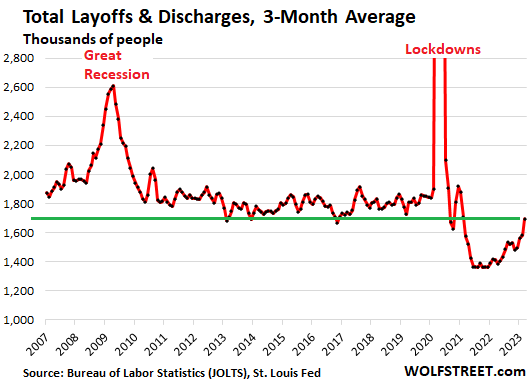
Churn in the workforce subsides. Has all this talk about layoffs had the effect that fewer people are quitting? Or is it that better jobs have gotten a little scarcer, and the grass isn’t much greener on the other side of the fence?
Voluntary quits have been on decline for months. The trend from the bottom during the employment crisis in 2009 through the Good Times in February 2020 had risen steadily, as job opportunities got better and more plentiful. Quits in 2019 exceeded historic highs. Then came the pandemic and all the gyrations in the labor market, and now the number of quits is still 10% above 2019, but has been below the Good Times trend line (green line). There is still a lot of churn in the labor market, but not nearly as much as there was:
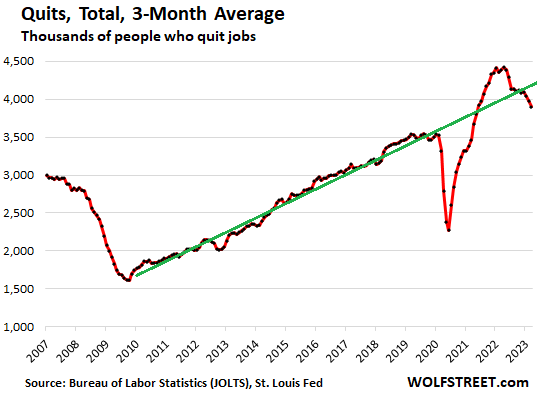
Job openings in major sectors.
Professional and business services, a big category with 22.4 million employees, include Professional, Scientific, and Technical Services; Management of Companies and Enterprises; Administrative and Support, and Waste Management and Remediation Services. Some of the tech and social media companies are in this category (others are in “information” or in other categories).
The huge number of job openings has deflated some but remains very high. The three-month moving average, at 1.89 million, is still up by 38% from the same period in 2019:
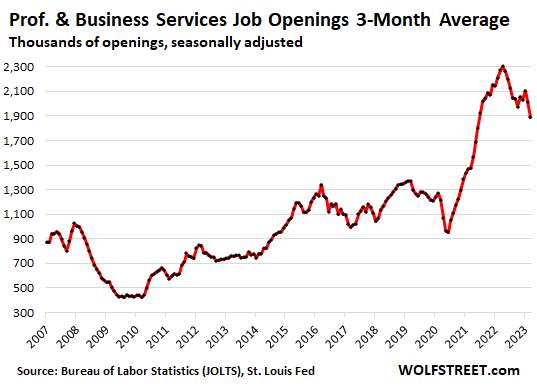
“Information” is a small sector with 3 million employees at companies engaged in web search portals, data processing, data transmission, information services, software publishing, motion picture and sound recording, broadcasting including over the Internet, and telecommunications.
So this is kind of funny. But that’s how it works. Job openings started plunging in mid-2022 through December, the worst plunge since the Dotcom Bust. But then they rose, and in March they rose for the third month in a row, and sharply, to 187,000 opening. These three monthly rises in a row caused the three-month moving average to jump.
In other words, even while mass-layoffs are still being implemented, companies are now looking for the right workers again – and there are still a lot of job openings in that sector, just not the crazy levels of early 2022.
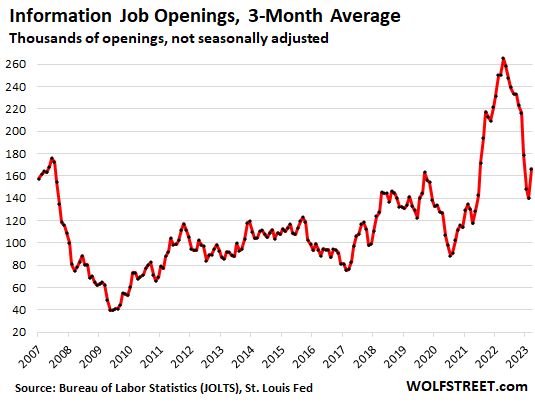
Leisure and hospitality, with about 16 million employees. The three-month moving average dropped for the third month in a row, but remains very high at 1.51 million job openings, 44% higher than in the same period in 2019:
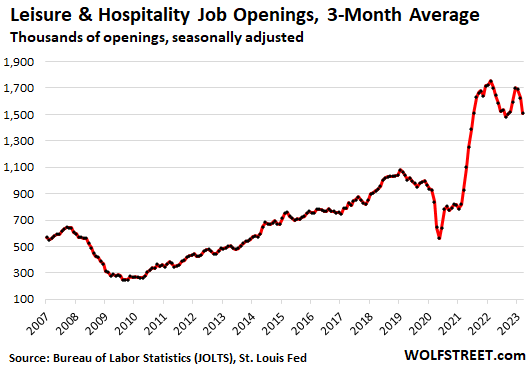
Healthcare and social assistance, with about 21 million employees: the three-month moving average of job openings has now fallen for 10 months in a row, from the astronomical zone, down to a still very high 1.71 million, 42% higher than in 2019:
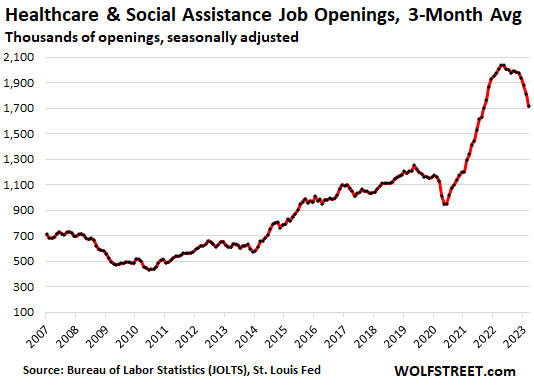
Retail trade, with about 16 million employees, normalized in mid-2022 and has stayed in the same range, with the three-month moving average at 806,000 job openings, about flat with the same period in 2019:
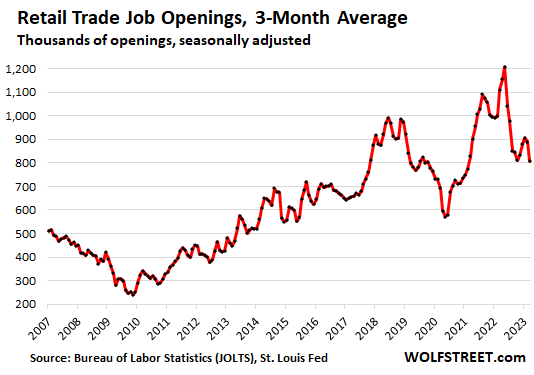
Education/state & local government job openings, most of them in education, stabilized last year near record high levels and have not really come down from there, with the three month-moving average at 885,000 job openings, 52% higher than in the same period in 2019, as many school districts still have a very hard time hiring enough teachers.
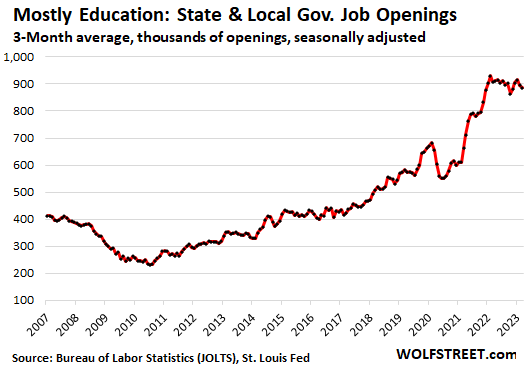
Manufacturing, with about 13 million employees, has been trimming the huge number of job openings it had. But the three-month moving average of 711,000 opening is still 60% higher than it was in the same period in 2019:
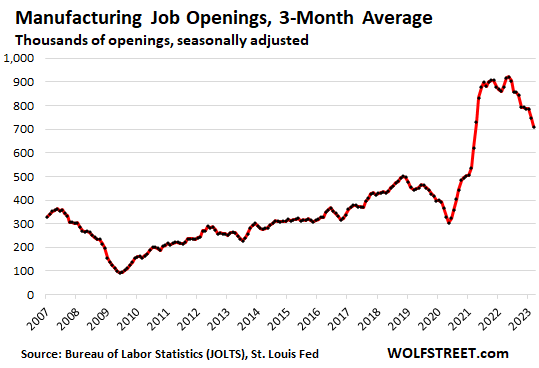
Construction, with about 8 million employees in all types of construction, from powerplants to single-family housing, has trimmed job openings this year, from very high levels last year. In the West, particularly in California, the horrendous rains and flooding over the first three months this year slowed a lot of construction work — and hiring for that work. So we’ll be looking at the next few months for clarification.
In March, the three-month average dropped to 343,000 job openings, about 8% higher than in 2019:
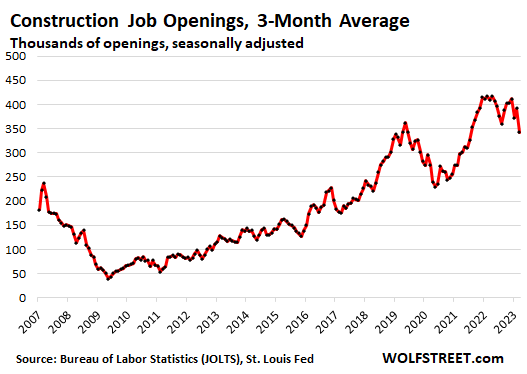
Enjoy reading WOLF STREET and want to support it? You can donate. I appreciate it immensely. Click on the mug to find out how:
![]()


There’s so much money created / materialized / conjured the last three years, that companies & government entities are still just trying to use it.
My employer just finished spending Covid money on air conditioning stuff. Our AC was some of the best around, but now it’s hospital grade. All buildings, all campuses.
There’s still some backlogs in materials and on the labor side, not enough people to do it all… because of all the money still sloshing around. Contractors are chasing left and right.
So, we now have awesome AC for buildings that are maybe 70% full from 2019. Yay!
And now that everyone in the USA is totally ensured up to a million, trillion dollars in their bank accounts (Thanks, SVB et. all), no need to worry about bank failures, Fed hikes or any of that nonsensical old-school financial stuff from long ago!
Money was not created, currency (USD) was created. While currency can be created by pressing a button, creating real money requires productive work that adds value to goods and services.
Creating currency didn’t make America rich, it only ensured that balance sheets remain balanced. At the same time debt increased and society became poorer with inflation.
You’re confusing value, money, and currency. Value isn’t money, but is measured by money. Money is created – out of thin air, on computer screens – primarily by bank loans and Federal transfer payments. Currency is the physical form of money, and accounts for a small amount of all $US.
They need to adjust the board game of Monopoly to introduce money printing and inflation.
I suggest the following changes:
1) Every time you pass Go, the property prices goes up $10% due to inflation.
2) Every round, the bank issues $5,000 to each player, automatically.
3) If you go bankrupt, you can roll the dice and try to get another $10,000 from the bank to keep playing. If you are the banker in charge, you don’t have to roll at all. You just get the money.
4) A new chance card will allow the wealthiest player to change any rule to his liking, as long as the rule change is approved by the second wealthiest player.
5) If the game runs more than 60 minutes, the two wealthiest players can agree to acquire and consolidate the properties of other players, who must leave the game. After 70 minutes, the two largest players can call a stalemate.
So you are complaining about upgraded AC where you work? Well done…you are a member of the elite, the worried well. Enjoy!
I often complain about systematic waste, even waste I benefit from. Am I part of the elite?
Trick question: Im descended from Charlemagne.
So, in last 2 days, 10 year fell from 3.6% to 3.4% on account of expected Fed hike of 0.25%! Wonder why Fed has no influence on bond markets any more?
It seems like repeat of 2008, with the difference that, instead of directly handing over money to the small banks, now the bailouts are handed to big banks that takeover these small banks. It confuses most people to think that it’s FDIC receivership and not Socialism for Billionaires!
At the same time the working class is hammered with high inflation and withdrawal of various pandemic programs and no bailouts!
Ah yes the lag effects. Starting to hit like a hammer upside the head. Give it a few months and see the real excitement.
I have to agree contractors have gone wild
We decided to do decent size job ourselves after contractor kept raising his bid
once it hit a certain level – we took it instead
said see yah, and hey thanks for the nice income
job should be done tomorrow then its time to get paid
and since I write the checks – it’s pay me week
Good charts. Thanks!
Played golf today with two home builders in Austin area small scale builders. One used to build in Highland park and still has a home in Highland Park Horseshoe Bay in Austin area and now in East Texas. All are probably 1.0mm plus . The Dallas area home sits empty and I asked him why he said it just keeps rising in value his annuity. They both are spending like crazy are 66 years old and the Austin area builder says he is going to raise the price of his custom home when he lists it. No signs of them cutting back spending. They both said they are not getting any younger so it’s spend spend spend.
This behavior is the very essence of a bubble.
These guys have the memory span of a goldfish.
Sadly now from TikTok and instagram the average goldfish has a longer attention span than a human…
Not to be that person, but goldfish actually get a bad rap and have been shown to have pretty good memory. But to your point, theirs wouldn’t have beaten a human’s… until social media.
The memory of a ferret on crack.
I am not surprised.
Because of FED policy, we still have too much money sloshing around the economy.
If you look at the asset bubble, it has not yet taken a serious hit ( except crypto ).
Apart form rate hikes, FED needs to do more aggressive QT
Horseshoe Bay isn’t Austin area by a long damn’d shot. Only a bloody golf playing Californian would think that.
RIP Austin
Out here around San Diego, everything for miles names itself “La Jolla” to sound like the rich neighborhood. It’s another kind of inflation: print charisma.
Good point phl:
While back, a well known ”developer” got himself elected US Rep for an area in FL in a, let’s just say less desirable area, and then as a USA “Representative, ( Congress person ) had the USPS change the zip code and address name to a
”much mo betta” area,,,
so that he could charge a TON more for the dirt he had bought from the farmers…
Isn’t USA wonderful???
That’s rational behavior. If you are in your 60’s and have a wad, you can either spend it or give it away. I think all the stock and RE inflation the Fed begged for is finally coming home to roost. Baby Boomers are now spending their wads, or giving it to kids who will spend it.
The Fed needs to reduce asset prices to rid inflation from the system and eliminate the generational inequities it created.
Every time Powell hears complaints that the economy is tanking, he should respond with:
“Financial conditions remain loose. Short-term and long-term interest rates are below the level of inflation. Equity and RE prices remain elevated. Employment is above trend.”
“In other words, even while mass-layoffs are still being implemented, companies are now looking for the right workers again…”
The right worker are ones who accept a much smaller paycheck then the ones who got laid off.
100% this.
NO, caffeinatteded one,,,
Still pretty sure that in spite of the various and sundry and extensive ”wokeness” working its way around and through the USA these days, MOST if not all employers still want folks who are at least competent.
IF NOT,,, say good bye to USA, sooner rather than later,,,
as the others,,, in this case many many others envious and between VERY competent and now clearly demonstrated far beyond basic competencies will soon prevail. etc.
Then will come the debacle…
Powell and his buds of all descriptions seem to have NO CLUE to the results of these ”social” movements.
Gonna be an amazing show IMHO,,, , as many on Wolf’s
Wonder have alleged.
Trillions printed, lock down the world, and watch what happens. Pure insanity.
Sorry for off topic post, but the huge short sellers raid on regional banks should be addressed now. Shorted stocks of regional banks now approach 100% of the outstanding float. This needs to stop. Many investors, myself included, are uncertain about the future path, and have pulled back from the market in regional bank stocks. But if short sellers persist in driving these banks out of business the country will lose a vital segment of its banking infrastructure. The authorities need to ban short selling in regional banks immediately in accordance with their fiduciary responsibilities.
Nah. Let them crash & burn. Then the speculants will learn. Unfortunately it’s the insane running the asylum nowadays.
Yeah, but it is the collateral damage, the externalities visited upon all our heads, to be concerned about. “I told you so” might feel good momentarily, but in a landscape collapsing on all our heads, it is small beer. Fools and knaves finally getting their comeuppance, and the universe rebalancing justly, isn’t enough reward to compensate personal disaster.
We live in a world where the wicked are never punished.
Sounds like you work for JPM. I guess nothing wrong with allowing a few “too big to fail” banks control the market.
How would short sellers be able to drive a bank out of business, unless the bank is already short on cash and needs to do a capital raise?
I was wondering the same.
“How would short sellers be able to drive a bank out of business?”. Its simple, the rapidly declining stock price scares depositors who then withdraw their funds, causing the bank to become insolvent (can’t sell their AVS and HTM securities to raise cash because of large losses) and forcing the FDIC to shut it down to limit their losses.
Short selling does not drive a stock’s price down.
Arnold,
“Short selling does not cause a stock price to go down.”
I think you need a class in Economics 101.
Hey wolf,
I’ve been buying a bunch of 4 week bonds last several months, but the yields on those are lower now than HYSAs so Im considering switching to 8 week bonds due to the sweet 5+% yields.
My question is, if the US for the first time since the last 78 times defaults on debt will that money be potentially gone or will they pay it back once the debt ceiling has been raised?
Hi Troy, I asked the same question a while back. Look for my username in the comments of this article: https://wolfstreet.com/2023/04/20/short-end-of-the-treasury-market-goes-totally-nuts-doubts-creep-in-over-debt-ceiling/
Long story short he believes people will be made whole whenever the (short lived) default is over and that people may even get interest during this time.
If the US defaults in some form — likely on some payments such as military salaries or Social Security benefits — there’s going to be huge amount of fireworks.
If there is a maturity default, no one knows what’s going to happen. It will be a huge mess in the markets. If this maturity defaults hits your bond issue, you will get your money eventually, plus interest, but there will be a gigantic mess all over the place before you get that money.
Once the debt ceiling is raised, all past due payments will be made — so that part I would not worry about.
Thank you Wolf!
Any program that is accounted for separately with a trust fund, and is currently solvent, such as Social Security, will be funded. I would guess the Fed would provide any necessary liquidity with a swap line. After that, who knows? It may be that the federal government is like Twitter; lay off two thirds of the workforce and the machine keeps going.
A default would definitely affect Social Security recipients. Social Security pays out more than it takes in.
Maybe Sec Yellen will mint that $1 trillion platinum coin?
No government ever has to default. They just make payments in Zimbabwe style money.
Troy, Wolf,
Here is what I feel. This circus has been played too many times and possibility of default is negligible.
Also, as Fed can always print USD outside debt ceiling, so, even with an expected govt default, holding TBills may be much better than cash in Bank.
In rare default, I expect gold and commodities to rise atleast 3 fold in short term.
In longer term, US is stuck irrespective of default. Debt is unsustainable and there is no sign of Austerity. So I feel it would be slow default through High inflation, that has been happening for last couple of years. This inflation will keep going higher as debt keeps increasing till this hopelessly broken system gives way.
A realistic view today is not very optimistic.
My employer was laying off in all areas, and trying to outsource as much work as possible in order to get the company ready to be chopped up and sold.
I knew it was getting bad when, in a company of about 700 employees, they were sending out weekly e-mails with the list of names of employees no longer with the company. I figured my name would soon be on that list, and it was as of April 24.
Hey – I got a nice severance package, especially for only being there 18 months.
Unfortunately, I’m over 55 so finding work will be tougher than in the past. I’m going government worker if possible – I worked 5 years for a city fresh out of college, and I made my wealth in the stock market.
So now I’m in it for the pension.
@Taxman100,
A former co-worker of mine was a “sustaining engineering manager” at a company in Southern CA. He got laid off in early April. He is 62. I thought he was going to have a hard time finding a job because of his age. I called him last night to see how things were going. He was very happy. He was offered a job. He said he was worried, because the last time he was laid off it took him 6 months to find a new job. So maybe you will find something too.
Housing has turned down.
New Orders have turned down.
Corporate earnings have turned down.
The last step before the stock market crash is increasing unemployment. Let’s call it the Kantrowitz Procession.
Fed raising interest rates strong and fast. Banks tightening lending standards. Severe inflation. Hard landing dead ahead.
I’m just in it for the money.
Personally, I am loading up on 5% CDs and Treasuries this week with my huge pile of dry powder.
Trading capital looking for a rally after the last Fed rate hike to load up on SQQQ at 29 and SPXU at 13.
Suggest you do what I did in ’16, when age 70++,,
I had NO calls for interviews after sending resume:
”Redacted EVERY ”age” related item from resume,,, EVERY!!
Sent out resume and EVERY COMPANY called me in for interview…
In FL, as soon as they, employers, saw me, they did all they could to get me out of the door…
Other where, recruiters saw my resume and after their ”due diligence” was hired by a very good company in CA.
Really wanted to stay on with that very good co., but had to return to help with 90+ in laws,,, so former ”boss” hired me to WFH for several years, until I had had enough…
IMO, ”WORK” IS out there for those who want to contribute/work…
‘Individual results may vary.” LOL
My daughter is 42 and is a Profession Engineer that does electrical utility design. The company she worked for were all work from home utility design engineers specializing in substation projects.
The company was sold and new owner was mandating all employees sign a very restrictive employment agreement. She said no and jumped in the job market.
Three very good offers within a week all 100% work from home. Last day was Friday, accepted a job offer by following Wednesday for a big pay jump.
She said one offer was in San Diego. They were desperate to find design engineers as grid needs engineering design upgrades as EV transition continues. Engineers are a lot like doctors in that they specialize in specific areas and the pool of utility design engineers is pretty small.
I suspect EV rollout will stumble at least for a few years as real world kicks in as real world shortages of labor and hardware kick in. Not sure current state of electrical grid components, but supply chains had very long delays for basic items like meters and transformers last year.
Anyway, that’s one story in job market.
I live in SD. We’ve hired many lately. All start well into six figs. All very upset about housing cost here, in spite of their salary. Suggest you warn your daughter just in case she might be thinking sbout moving to SD. And if she does anyway, warn her about downtown. Enormous homeless problem. One of our newhires signed a rental lease downtown and can’t wait for it to end.
Healthcare has been claiming nursing shortage and posting job openings for years, right up to the GFC when suddenly if by magic (read: waist-deep BS) they had a glut of HCPs and were in a position to freeze hirings and induce mass layoffs. And then quickly back to claiming HCP shortage through the mid 2010’s up into the Pandemic (without actually replenishing lost staffing). And yet amid all the media coverage of retiring/burned out nurses when the Pandemic dust settled, the brass got their bonuses and HCPs started getting the ax yet again.
And we’re still being told they’re desperately hiring and begging us to have our HCP friends submit resumes. Except our HCP friends submitted resumes multiple times with no call backs 6+ months later. Staff meetings are a thing of sad hilarity as they regurg this nurse shortage shite and announce increases to our caseloads. Which stopped working the second they made Town Halls attendance mandatory so we can hear about our happy investors and record profits instead of minding our patients and scrambling over ever-diminishing resources. The doormat Florence Nightengales are fewer and farther between while the rest of us are speaking out, knowing damn well its falling on deaf ears.
Anyone wanna pass me the info on one of those lay-about do nothing six-figure Tech jobs? I’ve earned it. Hell, I’d be actually productive, unless thats a problem in which case I’ll book my 11am massage, sip my latte and be quiet.
“And we’re still being told they’re desperately hiring and begging us to have our HCP friends submit resumes. Except our HCP friends submitted resumes multiple times with no call backs 6+ months later.”
I hear this also from other industries and services. Not sure what to make of it. Something in this whole picture just isn’t adding up that is for sure. How are sidelined workers who are not applyinng for work living? Are welfare and Social Security disability type programs competing with industry and services for “people”? Is pandemic welfare moneystill holding out? Are there flaws in the data?
Many folks in their 50’s left the workforce, with enough savings, stock market, and RE gains to get through retirement. I know many of them. With financial cushion, aging parents, evolving corporate environment, and desire for free time, etc. it makes a lot of sense.
There are lots of two-earner older households that have accumulated millions of wealth. Two decades of money printing has practically dropped it in their lap. You don’t hear about it very much because its impolite to discuss wealth, especially the lucky kind of wealth stemming from counter-productive Federal Reserve policies.
That doesn’t hold water in healthcare though. Even back in ’06 and ’07 when hospitals were ‘desperate’ and offering recruitment bonuses of $15k+ and reimbursement of student loans, they weren’t calling applicants back. HCPs talk to each other. We are offered referral bonuses. We know when they aren’t calling referrals back, and they rarely are. Post GFC, all the nurses who took early retirement due to declining conditions pre-GFC came back to work out of necessity after their spouses lost employment, and yet we still heard of a shortage. Just don’t expect a call back regarding your application.
Its always been optics in this industry. Media reports talk out of both sides of the industry’s mouth: “shortage due to nurses leaving in droves post pandemic” and “there’s always been a shortage”. Well which is it? And how do layoffs and hiring freezes happen when there’s a supposed constant and visibly worsening shortage? MSK laid off most of its cancer center staff recently, another local health system that shall remain nameless laid off most of a radiology dept and many other units got the cut with a hiring freeze after an internal campaign to scare workers into resigning lest be laid off post-pandemic. Brass took home some sweet bonuses and promotions though, with multiple greenlighted new corporate officer positions.
Staffing is at a shoestring, local nurses are leaving/striking, and travels are refusing assignments (travels are paid more via hospital write-off, hiring travels vs intermal staff help the bottom line). And yet nursing school attendance/graduation is lush as ever, and new grads continue to struggle to be hired. The industry does its damndest to keep layoffs out of the press but its the biggest employer of women in the country, you can’t hide this stuff in a quick sound bite.
From here in the cheap seats it doesn’t feel to be a conspiracy but does feel like a crescendo
of decades of gross mismanagement and infatuation with investor and corporate gluttony at the expense of patients and staff. The fact England is embracing switching to this model is mibdblowing.
When I was working and raising a family we were turning over a lot of money for not a very happy life. Work, work, work, drive, drive, drive, spend, spend, spend. Good for the tax man.
Right now I am in the sweet spot of early retirement with good health. About $1000 / month is all it takes now.
the whole economy is simply a product of all the money the Fed printed into it. This is not an organically made real wealth economy with real wealth owners like in the past, its a fake economy with mostly fake jobs and people with paper wealth but everything levered against with unsustainable real debt. When the debt starts imploding stocks and R.E. like it started on banks and commercial R.E. you will start to see through the printing the real economy, just like we saw in 2000 and 2008. I dont even look at job openings because they mean nothing now from excess printing Besides a company lays off one $100k job and advertises 3 $25k jobs and we have more jobs? Id look at workforce participation rate, tax receipts, GDP, and net worth trendline graph of the bottom 70%. This inflation is just a force of nature to bring equilibrium back or fake to real The debts are starting to finally matter and they go in dominoes. Once started all the fake is now at risk and Id say the fake to real is levered at 50 or 100 to one so it wont take much Does anyone remember all the rich from the internet stock boom 1998-2000, or all the retired rich from the massive housing wealth boom from 2001-2007? So it will go again. Paper wealth is not real and many retired rich will be found no more again. Every single asset it seems is facing a total debt induced repricing event including the dollar upcoming regardless now of what the Fed does. Realized wealth minus liabilities…how you doing..Washington, Wall St, Financial system, jobs…
had a cocktail with a acquaintance project manager with a large building/engineering firm – his insight is projects in the private business category slowing and very cost conscious – public spending – hospital – college – is going up fast and is much more profitable – “they want the best of everything and are not cost conscious”
First Republic Bank Stock Still Trading!!!
FRCB $0.3094 -3.2006 -91.19%
Last Updated: May 3, 2023 10:59 a.m. EDT
Turned on the local financial news this morning and I cannot get any local news anymore. All I hear is news about SFO, nonstop. Northstrums closing 2 stores, Whole foods closing stores because of theft. Downtown office vacancy rate of 30%. What is this obsession with the media about SFO?
”Canary in the mine” SC is my opinion re focus on SF.
Thanks for your many reports from boots on the ground.
If you can stick “San Francisco” in the headline, it becomes very effective global clickbait. These people will click on it no matter what if it has San Francisco in the headline, they’re programmed to. Nordstrom closed dozens of stores around the country. Tens of thousands of department stores were closed around the country over the past five years. But only if it has “San Francisco” in the headline, it’s a go. Bloomberg and other media outlets will publish all kinds of dumb shit to get clicks. It would not surprise me to find out that the article was written by a bot — lots of articles, including Bloomberg’s, are written by bots.
Wolf
It was probably written by AI as a test case. I noticed the two big AI stocks went up this past week. ha ha
…Noo Yawk City ain’t what it used to be (even in terms of being the “heartland’s” favorite whipping boy)…
may we all find a better day.
I find the historic growth peculiar. What’s the driver of such a steady linear growth rate over many years, but at a rate that’s very much greater than population and gdp growth? Seems like something that has a clear underlying mathematical cause. Anyone know what that is?
Comparing the numbers, it looks like it might be mostly down to the quits. But why has that been following a close to linear trend? Something to do with the workforce age profile?
Wolf,
I know that now and 2007 are not apples to apples but I want to ask you that for similar charts in this page, extend the date back 3 -4 year from 2007, so we can see the picks and get some information about the conditions 3-4 year before the bust. I am really want to see them. I appreciate your time.
It didn’t look similar at all. See below.
This was the first time I shifted the beginning of the data to 2007, from 2001, because all the details of 2023 were getting lost.
You can get the charts going back to 2001 in my old articles on this. The old pre-2007 data won’t change, so bookmark this article for next time you have questions about pre-2007 stuff. For example this one:
https://wolfstreet.com/2022/02/01/layoffs-quits-hires-job-openings-the-phenomenon-of-labor-shortages-and-the-power-shift-from-employers-to-workers/
Thank you so much
It’s still near impossible to get a job if you are over 50. I applied to over 500 jobs and not even an interview.
Ageism is a huge problem.
My experience is hiring managers want a younger version of themselves – they think they will find someone who will put up with brutal hours for the promise of a promotion. They don’t understand the younger generation has seen how their parents were treated by Corporate America, and they won’t play that same game.
Back in the day, a promotion to Manager meant you worked only 40 hours a week – it was the staff that worked overtime. So if you are working the same hours with more stress, just to pay more taxes and buy junk you don’t need, where is the payoff?
Another thing that changed in my career in accounting – when I started you got paid meal money if you worked more than 10 hours in a day, plus you only worked until Noon on Fridays during the summer. At the same time, the expectation is you would spend most of your professional career with one employee, so you were mentored and treated as such.
All of that has disappeared – their solution to the difficulty in finding workers is to outsource to India, Central America, etc., and beg the Federal Government to allow more foreign work visas.